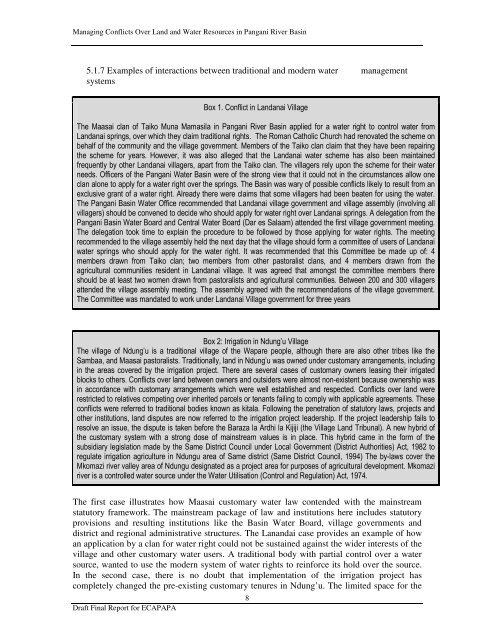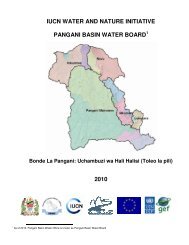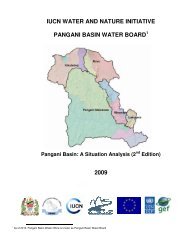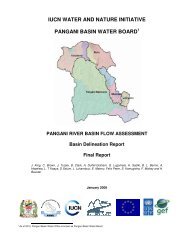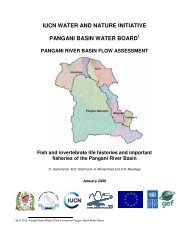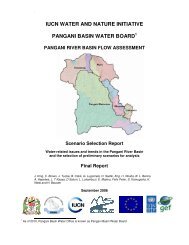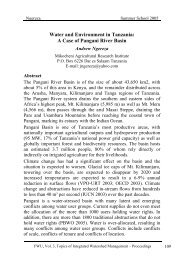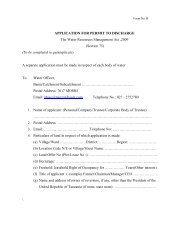Managing Conflicts Over Land and Water Resources in Pangani River
Managing Conflicts Over Land and Water Resources in Pangani River
Managing Conflicts Over Land and Water Resources in Pangani River
You also want an ePaper? Increase the reach of your titles
YUMPU automatically turns print PDFs into web optimized ePapers that Google loves.
<strong>Manag<strong>in</strong>g</strong> <strong>Conflicts</strong> <strong>Over</strong> <strong>L<strong>and</strong></strong> <strong>and</strong> <strong>Water</strong> <strong>Resources</strong> <strong>in</strong> <strong>Pangani</strong> <strong>River</strong> Bas<strong>in</strong><br />
5.1.7 Examples of <strong>in</strong>teractions between traditional <strong>and</strong> modern water management<br />
systems<br />
Box 1. Conflict <strong>in</strong> <strong>L<strong>and</strong></strong>anai Village<br />
The Maasai clan of Taiko Muna Mamasila <strong>in</strong> <strong>Pangani</strong> <strong>River</strong> Bas<strong>in</strong> applied for a water right to control water from<br />
<strong>L<strong>and</strong></strong>anai spr<strong>in</strong>gs, over which they claim traditional rights. The Roman Catholic Church had renovated the scheme on<br />
behalf of the community <strong>and</strong> the village government. Members of the Taiko clan claim that they have been repair<strong>in</strong>g<br />
the scheme for years. However, it was also alleged that the <strong>L<strong>and</strong></strong>anai water scheme has also been ma<strong>in</strong>ta<strong>in</strong>ed<br />
frequently by other <strong>L<strong>and</strong></strong>anai villagers, apart from the Taiko clan. The villagers rely upon the scheme for their water<br />
needs. Officers of the <strong>Pangani</strong> <strong>Water</strong> Bas<strong>in</strong> were of the strong view that it could not <strong>in</strong> the circumstances allow one<br />
clan alone to apply for a water right over the spr<strong>in</strong>gs. The Bas<strong>in</strong> was wary of possible conflicts likely to result from an<br />
exclusive grant of a water right. Already there were claims that some villagers had been beaten for us<strong>in</strong>g the water.<br />
The <strong>Pangani</strong> Bas<strong>in</strong> <strong>Water</strong> Office recommended that <strong>L<strong>and</strong></strong>anai village government <strong>and</strong> village assembly (<strong>in</strong>volv<strong>in</strong>g all<br />
villagers) should be convened to decide who should apply for water right over <strong>L<strong>and</strong></strong>anai spr<strong>in</strong>gs. A delegation from the<br />
<strong>Pangani</strong> Bas<strong>in</strong> <strong>Water</strong> Board <strong>and</strong> Central <strong>Water</strong> Board (Dar es Salaam) attended the first village government meet<strong>in</strong>g.<br />
The delegation took time to expla<strong>in</strong> the procedure to be followed by those apply<strong>in</strong>g for water rights. The meet<strong>in</strong>g<br />
recommended to the village assembly held the next day that the village should form a committee of users of <strong>L<strong>and</strong></strong>anai<br />
water spr<strong>in</strong>gs who should apply for the water right. It was recommended that this Committee be made up of: 4<br />
members drawn from Taiko clan; two members from other pastoralist clans, <strong>and</strong> 4 members drawn from the<br />
agricultural communities resident <strong>in</strong> <strong>L<strong>and</strong></strong>anai village. It was agreed that amongst the committee members there<br />
should be at least two women drawn from pastoralists <strong>and</strong> agricultural communities. Between 200 <strong>and</strong> 300 villagers<br />
attended the village assembly meet<strong>in</strong>g. The assembly agreed with the recommendations of the village government.<br />
The Committee was m<strong>and</strong>ated to work under <strong>L<strong>and</strong></strong>anai Village government for three years<br />
Box 2: Irrigation <strong>in</strong> Ndung’u Village<br />
The village of Ndung’u is a traditional village of the Wapare people, although there are also other tribes like the<br />
Sambaa, <strong>and</strong> Maasai pastoralists. Traditionally, l<strong>and</strong> <strong>in</strong> Ndung’u was owned under customary arrangements, <strong>in</strong>clud<strong>in</strong>g<br />
<strong>in</strong> the areas covered by the irrigation project. There are several cases of customary owners leas<strong>in</strong>g their irrigated<br />
blocks to others. <strong>Conflicts</strong> over l<strong>and</strong> between owners <strong>and</strong> outsiders were almost non-existent because ownership was<br />
<strong>in</strong> accordance with customary arrangements which were well established <strong>and</strong> respected. <strong>Conflicts</strong> over l<strong>and</strong> were<br />
restricted to relatives compet<strong>in</strong>g over <strong>in</strong>herited parcels or tenants fail<strong>in</strong>g to comply with applicable agreements. These<br />
conflicts were referred to traditional bodies known as kitala. Follow<strong>in</strong>g the penetration of statutory laws, projects <strong>and</strong><br />
other <strong>in</strong>stitutions, l<strong>and</strong> disputes are now referred to the irrigation project leadership. If the project leadership fails to<br />
resolve an issue, the dispute is taken before the Baraza la Ardhi la Kijiji (the Village <strong>L<strong>and</strong></strong> Tribunal). A new hybrid of<br />
the customary system with a strong dose of ma<strong>in</strong>stream values is <strong>in</strong> place. This hybrid came <strong>in</strong> the form of the<br />
subsidiary legislation made by the Same District Council under Local Government (District Authorities) Act, 1982 to<br />
regulate irrigation agriculture <strong>in</strong> Ndungu area of Same district (Same District Council, 1994) The by-laws cover the<br />
Mkomazi river valley area of Ndungu designated as a project area for purposes of agricultural development. Mkomazi<br />
river is a controlled water source under the <strong>Water</strong> Utilisation (Control <strong>and</strong> Regulation) Act, 1974.<br />
The first case illustrates how Maasai customary water law contended with the ma<strong>in</strong>stream<br />
statutory framework. The ma<strong>in</strong>stream package of law <strong>and</strong> <strong>in</strong>stitutions here <strong>in</strong>cludes statutory<br />
provisions <strong>and</strong> result<strong>in</strong>g <strong>in</strong>stitutions like the Bas<strong>in</strong> <strong>Water</strong> Board, village governments <strong>and</strong><br />
district <strong>and</strong> regional adm<strong>in</strong>istrative structures. The Lan<strong>and</strong>ai case provides an example of how<br />
an application by a clan for water right could not be susta<strong>in</strong>ed aga<strong>in</strong>st the wider <strong>in</strong>terests of the<br />
village <strong>and</strong> other customary water users. A traditional body with partial control over a water<br />
source, wanted to use the modern system of water rights to re<strong>in</strong>force its hold over the source.<br />
In the second case, there is no doubt that implementation of the irrigation project has<br />
completely changed the pre-exist<strong>in</strong>g customary tenures <strong>in</strong> Ndung’u. The limited space for the<br />
Draft F<strong>in</strong>al Report for ECAPAPA<br />
8


